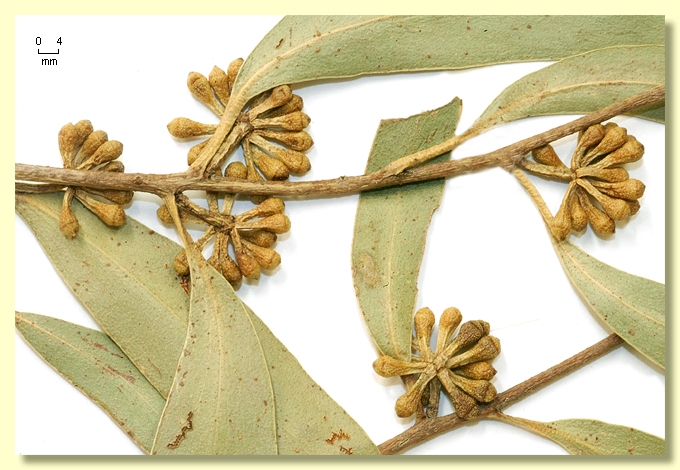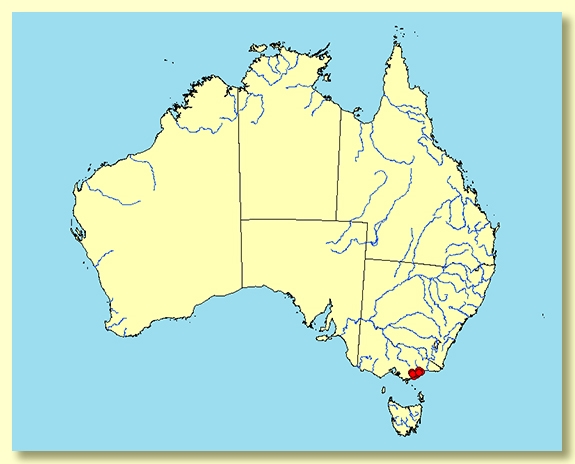Euclid - Online edition
Eucalyptus arenicola
Eucalyptus | Eucalyptus | Aromatica | Radiatae
Eucalyptus arenicola Rule, Muelleria 26(2): 91-94 (2008).
T: Victoria. 5.1 km WSW of Loch Sport, 38 04'S 147 33'E, K.Rule 0421, 6.ii.2004; holotype: MEL; isotype: AD, CANB, HO, NSW
Spreading trees to 15 m tall, or mallees to ca 4 m. Forming a lignotuber.
Bark rough, extending to limbs to about 5 cm diameter, fibrous, peppermint-type, dark grey, smooth bark cream and pale grey.
Juvenile growth (coppice or field seedlings to 50 cm): stem rounded in cross-section, smooth or slightly warty; juvenile leaves opposite and sessile for many pairs, lanceolate, 6–9 cm long, 1.4–2.7 cm wide, bases stem-clasping, dull, blue-green to grey-green or green.
Adult leaves alternate, petiole 0.5–1.3 cm long; blade lanceolate or more or less linear, (7.3)8-13(14) cm long, 0.7–1.8 cm wide, base tapering to petiole, concolorous, slightly glossy (rarely completely dull), blue-green to dark green, side-veins very acute to almost parallel to midrib, sparsely reticulate, intramarginal vein close to margin, oil glands island.
Inflorescence axillary unbranched, peduncles 0.2–1.5 cm long, buds 11 to 25 per umbel, pedicellate (pedicels to 0.2–0.6 cm long). Mature buds obovoid or clavate, 0.3–0.4 cm long, 0.3–0.4 cm wide, green to yellow, scar absent, operculum usually rounded, stamens inflexed, anthers reniform to cordate, versatile, dorsifixed, dehiscing by confluent slits, style much shorter than bud cavity, stigma tapered, locules usually 4, the placentae each with 2 vertical ovule rows. Flowers white.
Fruit with pedicels 0.1–0.6 m long, hemispherical, 0.4–0.6(0.7) cm long, 0.5–0.8(0.9) cm wide, disc slightly raised-convex to annular, or level, valves usually 4, near rim level or just enclosed.
Seeds brown, 1–2.5 mm long, pyramidal or obliquely pyramidal, dorsal surface smooth, hilum terminal.
Cultivated seedlings (measured at ca node 10): cotyledons reniform; stems rounded in cross-section, warty, non-glaucous; leaves sessile, opposite for many nodes (still opposite at node 15), lanceolate, 8.8–12.0 cm long, 1.5–2.7 cm wide, amplexicaul, margin entire, apex pointed, discolorous, blue-green to green.
Flowering has been recorded in September.
Eucalyptus arenicola is a rough fibrous-barked peppermint-scented woodland tree or a multistemmed mallee endemic to east Gippsland, Victoria, found growing from Yarram and Loch Sport north to Rosedale and almost to Bairnsdale. It occupies sandy sites on the low-lying old marine plain. It has dark green to bluish green slightly glossy foliage, small club-shaped buds and hemispherical fruit.
Until recently this species was included in E. willisii subsp. willisii, a taxon now regarded as restricted to Wilsons Promontory on undulating granite country, and probably also around Leongatha, French Island and Westernport. E. arenicola differs from E. willisii subsp. willisii in having slightly larger, more hemispherical fruit (fruit only 0.4-0.6 cm wide in subsp. willisii), slightly narrower juvenile leaves on coppice growth and a tendency to have slightly glossier adult leaves. None of these distinctions are particularly clear cut.
If you are trying to identify lowland peppermint eucalypts in the Gippsland Lakes hinterland they will most likely be E. arenicola; on the gentle foothills immediately to the north of Bairnsdale and Stratford you will find E. croajingolensis, a fully rough barked peppermint tree with slightly smaller fruit (0.4-0.6 cm wide), generally more truncate-globose in shape, broader dull predominantly bluish green adult leaves 1.2-4.2 cm wide and bud clusters that are glaucous at least when young though this may be lost as the buds age. Occasional plants found north of Yarram and near Longford also seem to have the fruit and bud characteristics of E. croajingolensis but have the form of E. arenicola and white sand habitat, and may represent either taxon or be plants with intermediate morphology between E. croajingolensis and E. arenicola.
On the hills around Tynong and Woori Yallock broad-leaved peppermints with glossy adult leaves and broad ovate bluish juvenile leaves are E. dives,while woodland trees on the Mornington Peninsula e.g. at Cranbourne, are E. radiata subsp. radiata. Taller trees on the South Gippsland ranges with dull to slightly glossy greenish to blue-green narrow adult leaves and narrow juveniles, and buds with conical operculum, are also E. radiata subsp. radiata.
In the classification of Brooker (2000) the more recently describedEucalyptus arenicola would belong in Eucalyptus subgenus Eucalyptus section Aromatica (the peppermints) because the buds have a single operculum, anthers are reniform, ovules are in two rows, seeds are more or less pyramidal, adult leaf venation is acute to parallel and juvenile leaves are sessile and opposite for many pairs. Within this section six closely related species form series Radiatae, viz. E. elata, E. radiata (with three subspecies), E. croajingolensis, E. willisii (with two subspecies), E. arenicola and E. dives. They differ from each other in bark, leaf, bud and fruit characteristics but the distinctions are not always strong. As a group series Radiatae differs from the endemic Tasmanian peppermints, series Insulanae, by having numerous oil glands in the juvenile leaves (very few foliar oil glands visible in the Tasmanian species).
Extra notes comparing E. willisii subsp. willisii and E. arenicola can be found under the former.
Eucalyptus arenicola : from Latin arena meaning sandy, and cola, dwelling, referring to the species habitat on the old marine plain.









